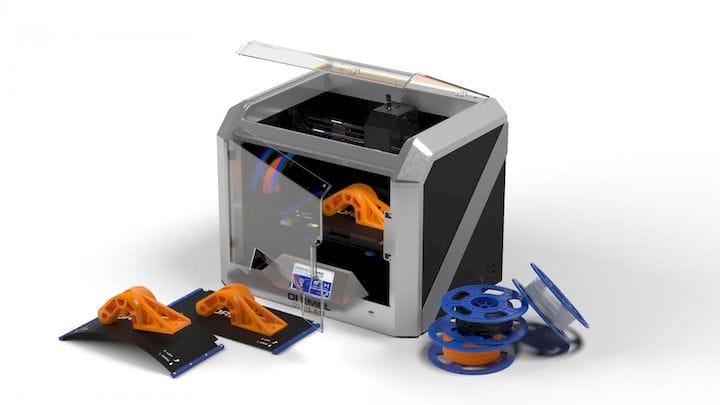![The Dremel 3D40 FLEX 3D printer for educators [Source: Dremel]](https://fabbaloo.com/wp-content/uploads/2020/05/image-asset_img_5eb09dd5c06bb.jpg)
Dremel announced a new desktop 3D printer, the Dremel DigiLab 3D40 FLEX 3D Printer.
Dremel, a Bosch brand, has been marketing 3D printers for several years, beginning with their Idea Builder in 2014. Since then they’ve released a number of different units.
I should point out that Dremel / Bosch is not making these machines themselves; instead they are made under contract by other notable 3D printer manufacturers. Some will notice similarities to other machines on the market, particularly those from Asia. Nevertheless, a machine is a machine and should be graded on its own performance.
Dremel first introduced their 3D40 line in 2016, marketing a new machine that specifically focused on the educational market. At that time many 3D printer manufacturers were scrambling to find buyers after the collapse of the consumer 3D printing market a year or so earlier. Dremel wisely selected the education market and made modifications to their equipment to better suit educators and their environments.
The 3D40 of 2016 included a number of useful features, including a fully enclosed build chamber to capture heat, active filament monitoring, enhanced cooling, touchscreen, networking and much more. It was a decent machine at the time.
Today we see they’re announcing the 3D40 FLEX 3D Printer. What makes it different from the 3D40?
It seems they’re focusing on throughput in the classroom, as the FLEX continues to be targeting the educational market. The “FLEX” part of its name refers to the major change: a flexible and removable print plate. This is something that’s been added to many other 3D printers recently and has become a bit of a de facto standard feature.
It allows for easy removal of prints by merely twisting the plate, causing any attached prints to detach as they’re typically more rigid than the plate. Of course, this doesn’t work at all with flexible materials, so ironically the “FLEX” won’t be so good for printing flexible filament.
Another capability with the flexible plate is to get more than one. When the first print completes, the plate and print can be quickly removed and replaced with a fresh second plate, which can almost immediately take on a second print. While that’s underway, the first print can be carefully removed from the first plate, adding a bit of parallelism to the operation and speeding operations up a bit.
Dremel has also included a “Draft Mode” that can print up to 30% faster. While this is merely a tweak of some print settings bundled into a button, it could be quite useful in classroom settings to make certain prints get done in good time.
This is quite important in a classroom setting, where there are more than likely fewer 3D printers than students, and there is a crush to get projects completed in the brief classroom durations.
However, Dremel also includes their powerful cloud-based printing solution with the machine, so students would be able to stack up prints for subsequent printing if they don’t get it done during class time.
Dremel includes a reasonable amount of associated material with the device, including lesson plans, tutorials, chip-based material spools that automatically configure the machine properly, software and online support. Features such as these, while not part of the machine itself, could be quite comforting to educators who are already stressed from setting up classes and handling students.
Note that because the spools are chip-driven, it is required that you use Dremel’s materials in this machine. This may mean your material costs could be somewhat higher than buying “open” filament from third parties that is done with other machines, but the benefit is that the Dremel 3D40 FLEX will know exactly what’s loaded and can take appropriate actions. This is likely a good scenario for a classroom with students still learning what to do.
One of my personal axioms is that if you want something to happen, make it easy to do. That seems to be a principle being followed by Dremel in the case of the 3D40 FLEX 3D printer. They are making it easier to get more prints done in the classroom.
The whole package is what educators would be buying in this case, and for that you will pay US$1,299 when the machine is available in February. While that price is somewhat higher than some less expensive options, they don’t come with the comprehensive educational package that’s supplied with each Dremel machine.
The battle for educational 3D printers continues.
Via PRNewswire and Dremel 3D Printing











FELIXprinters has released a new bioprinter, the FELIX BIOprinter, which is quite a change for the long-time 3D printer manufacturer.